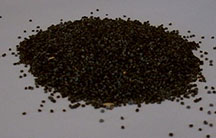
Other articles you might enjoy:
1. Take Time to Stop and Eat the Flowers
2. A Book Review: The United States of Arugula
4. Celebrate Breakfast with Herbs and Spices
5. Look What I Made: An Herb Drying Rack
Make the most of culinary herbs and spices.
All About Poppy Seeds
by Sandra Bowens

An anonymous count claims 900,000--that’s how many poppy seeds are said to be in one pound! It would take a long time to count these seemingly round, black seeds that are actually kidney shaped and slate-blue.
The culinary poppy seed is harvested from ripened and dried seed capsules of the plant Papaver somniferum, also known as the oriental or opium poppy. This is the same frilly flower that provides us with morphine and ultimately, when combined with other ingredients, opium and heroin. Our spice is formed long after the capsule has lost its potential to produce opium so it is not considered narcotic.
Poppy cultivation dates back to 1400 BC in Crete when it was grown for its sedative properties. Homer suggested poppies as an ornamental garden plant around 800 BC. While the plant has a long, tragic history that revolves around opium, use of the seed is tame.
Early Egyptians pressed the seed into a cooking oil. Recipes, or at least descriptions of methods, for creating a confection of poppy seeds and honey exist from the first century AD. Famous Greek physician Galen suggested the seeds be baked into a wholesome bread and a poppy seed spread was popular in the Middle Ages.
These applications are still in use today. Although poppy seed oil can be used in cooking, more likely it will turn up in paint processing. Poppy seed muffins and bagels are a common baked good these days. We can even buy a prepared poppy seed spread for filling pastries. Poppy seeds offer a nutty crunch no matter where they appear. To really bring out the flavor they should be roasted or crushed prior to using.
Dutch poppy seeds are considered the finest in flavor and quality but they are produced in other parts of Europe as well as in Australia. India markets white poppy seeds which are unripened and slightly more bitter than the blue variety.
While they may not meet the standards of Holland, it is possible to harvest your own poppy seeds for cooking. The spectacular flowers in your garden are rewarding enough but if you allow the seed pod, or capsule, to remain on the plant until it has dried out and the plant's leaves are dying, you can gather the ripened seeds for the kitchen. You'll know that the seeds are dry when you can hear them rattling about in the capsule but another clue is when a circle of half moons open up and away from the top. Then you can snip the stem, shake out the seeds and have a decorative poppy capsule for dried flower arrangements. (See author's note below.)
For culinary purposes you will want to make sure that you have the Oriental variety. As stated above, this is the Papaver somniferum or Papaver orientale. The seed capsules are rounded and about the size of a walnut. And, as always when using flowers in the kitchen, you should have grown them yourself without pesticides or other chemicals.
Other poppies are lovely for their flowers but not for the kitchen. The bright red poppy of Flanders Field fame is the corn poppy, Papaver rhoeas. The golden or California poppy is Eschscholzia californica. Another beauty is the Welsh poppy, Meconopsis cambrica.
No discussion of poppy seeds would be complete without exploring one topic: Read what Wikipedia says about the rumors that poppy seeds interfere with accurate drug testing.
Author's note: While it was great fun to do, my own culinary poppy seed collection project was rather disappointing. I gathered nearly a cup of seeds but they were a coffee-brown color instead of any shade of bluish black. Worst of all, they were practically flavorless, especially when I compared them to the high quality poppy seeds already in my spice cabinet.
Almond Poppy Seed Muffins
You decide how sweet you want these muffins to be. With the 1/2 cup sugar you get a tasty muffin that's not too sweet--good for the dinner table. Use a full cup of sugar if you're looking for a bakery-style treat.
1/4 cup poppy seeds
2 cups all-purpose flour
1/2 cup to 1 cup granulated sugar, depending on taste
1 teaspoon baking powder
1/2 teaspoon salt
1/4 teaspoon baking soda
1 egg
1 1/2 cups buttermilk
5 Tablespoons butter, melted
1 teaspoon almond extract
3 Tablespoons sliced almonds
Toast the poppy seeds by placing them in a small dry skillet over medium-high heat and stir constantly until fragrant, 2-3 minutes. Transfer to a small plate to cool.
Preheat the oven to 400 degrees. Butter the cups of a muffin tin, or coat with non-stick cooking spray.
Combine the flour, sugar, baking powder, salt, baking soda and the toasted poppy seeds in a medium mixing bowl. Make a well in the center and set aside.
In a small bowl, lightly beat the egg and then stir in the buttermilk, melted butter and almond extract. Pour this mixture into the well in the flour mixture. Quickly stir the liquids into the flour until just blended. Overmixing will result in tough muffins.
Divide the batter between the muffin cups, filling almost full. Sprinkle the sliced almonds over the top of the muffins.
Bake for about 15 minutes or until the tops are lightly browned. Remove from oven and cool in pan for 5 minutes. Carefully remove the muffins from the tin and cool on a rack or serve immediately.
Makes 1 dozen
Here's one that's full of our favorite recipes because we wrote the book! It is also full of information, helpful hints and ideas for using herbs and spices in your kitchen.
These darlings of the blogosphere take on classic desserts in their own quirky style.
The latest culinary mystery featuring Goldy as she whips up more tasty treats while chasing criminals in her neighborhood. See aPinchOf.com's review of this book.
Learn to bake with instructions from the professionals. Mouthwatering photographs and detailed recipes make this book a gem.
This is no cookbook but a serious look at spice history, cultivation and use.
This collection of recipes gathered from herb farmers and herb shop owners provides the inspiration to try something fresh and new.







